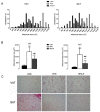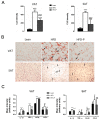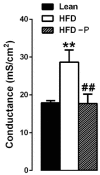Pistachio Consumption Alleviates Inflammation and Improves Gut Microbiota Composition in Mice Fed a High-Fat Diet
- PMID: 31935892
- PMCID: PMC6981517
- DOI: 10.3390/ijms21010365
Pistachio Consumption Alleviates Inflammation and Improves Gut Microbiota Composition in Mice Fed a High-Fat Diet
Abstract
High-fat diet (HFD) induces inflammation and microbial dysbiosis, which are components of the metabolic syndrome. Nutritional strategies can be a valid tool to prevent metabolic and inflammatory diseases. The aim of the present study was to evaluate if the chronic intake of pistachio prevents obesity-associated inflammation and dysbiosis in HFD-fed mice. Three groups of male mice (four weeks old; n = 8 per group) were fed for 16 weeks with a standard diet (STD), HFD, or HFD supplemented with pistachios (HFD-P; 180 g/kg of HFD). Serum, hepatic and adipose tissue inflammation markers were analyzed in HFD-P animals and compared to HFD and STD groups. Measures of inflammation, obesity, and intestinal integrity were assessed. Fecal samples were collected for gut microbiota analysis. Serum TNF-α and IL-1β levels were significantly reduced in HFD-P compared to HFD. Number and area of adipocytes, crown-like structure density, IL-1β, TNF-α, F4-80, and CCL-2 mRNA expression levels were significantly reduced in HFD-P subcutaneous and visceral adipose tissues, compared to HFD. A significant reduction in the number of inflammatory foci and IL-1β and CCL-2 gene expression was observed in the liver of HFD-P mice compared with HFD. Firmicutes/Bacteroidetes ratio was reduced in HFD-P mice in comparison to the HFD group. A pistachio diet significantly increased abundance of healthy bacteria genera such as Parabacteroides, Dorea, Allobaculum, Turicibacter, Lactobacillus, and Anaeroplasma, and greatly reduced bacteria associated with inflammation, such as Oscillospira, Desulfovibrio, Coprobacillus, and Bilophila. The intestinal conductance was lower in HFD-P mice than in the HFD mice, suggesting an improvement in the gut barrier function. The results of the present study showed that regular pistachio consumption improved inflammation in obese mice. The positive effects could be related to positive modulation of the microbiota composition.
Keywords: HFD mice; adipose tissue; gut microbiota; obesity-related inflammation; pistachio intake.
Conflict of interest statement
The authors declare no conflict of interest.
Figures







Similar articles
-
The metabolic and vascular protective effects of olive (Olea europaea L.) leaf extract in diet-induced obesity in mice are related to the amelioration of gut microbiota dysbiosis and to its immunomodulatory properties.Pharmacol Res. 2019 Dec;150:104487. doi: 10.1016/j.phrs.2019.104487. Epub 2019 Oct 11. Pharmacol Res. 2019. PMID: 31610229
-
Antrodia cinnamomea reduces obesity and modulates the gut microbiota in high-fat diet-fed mice.Int J Obes (Lond). 2018 Feb;42(2):231-243. doi: 10.1038/ijo.2017.149. Epub 2017 Jun 20. Int J Obes (Lond). 2018. PMID: 28630461 Free PMC article.
-
Pistachio Consumption Prevents and Improves Lipid Dysmetabolism by Reducing the Lipid Metabolizing Gene Expression in Diet-Induced Obese Mice.Nutrients. 2018 Dec 1;10(12):1857. doi: 10.3390/nu10121857. Nutrients. 2018. PMID: 30513740 Free PMC article.
-
High-Fat, Western-Style Diet, Systemic Inflammation, and Gut Microbiota: A Narrative Review.Cells. 2021 Nov 14;10(11):3164. doi: 10.3390/cells10113164. Cells. 2021. PMID: 34831387 Free PMC article. Review.
-
The Link between Gut Dysbiosis Caused by a High-Fat Diet and Hearing Loss.Int J Mol Sci. 2021 Dec 7;22(24):13177. doi: 10.3390/ijms222413177. Int J Mol Sci. 2021. PMID: 34947974 Free PMC article. Review.
Cited by
-
The diversity analysis and gene function prediction of intestinal bacteria in three equine species.Front Microbiol. 2022 Sep 7;13:973828. doi: 10.3389/fmicb.2022.973828. eCollection 2022. Front Microbiol. 2022. PMID: 36160217 Free PMC article.
-
Protective Effects of Dietary Resveratrol against Chronic Low-Grade Inflammation Mediated through the Gut Microbiota in High-Fat Diet Mice.Nutrients. 2022 May 10;14(10):1994. doi: 10.3390/nu14101994. Nutrients. 2022. PMID: 35631150 Free PMC article.
-
Regular Intake of Pistachio Mitigates the Deleterious Effects of a High Fat-Diet in the Brain of Obese Mice.Antioxidants (Basel). 2020 Apr 15;9(4):317. doi: 10.3390/antiox9040317. Antioxidants (Basel). 2020. PMID: 32326575 Free PMC article.
-
Effects of Peanuts and Pistachios on Gut Microbiota and Metabolic Syndrome: A Review.Foods. 2023 Dec 11;12(24):4440. doi: 10.3390/foods12244440. Foods. 2023. PMID: 38137244 Free PMC article. Review.
-
Association of the Gut Microbiota with Weight-Loss Response within a Retail Weight-Management Program.Microorganisms. 2020 Aug 16;8(8):1246. doi: 10.3390/microorganisms8081246. Microorganisms. 2020. PMID: 32824364 Free PMC article.
References
MeSH terms
Substances
LinkOut - more resources
Full Text Sources
Medical
Research Materials

